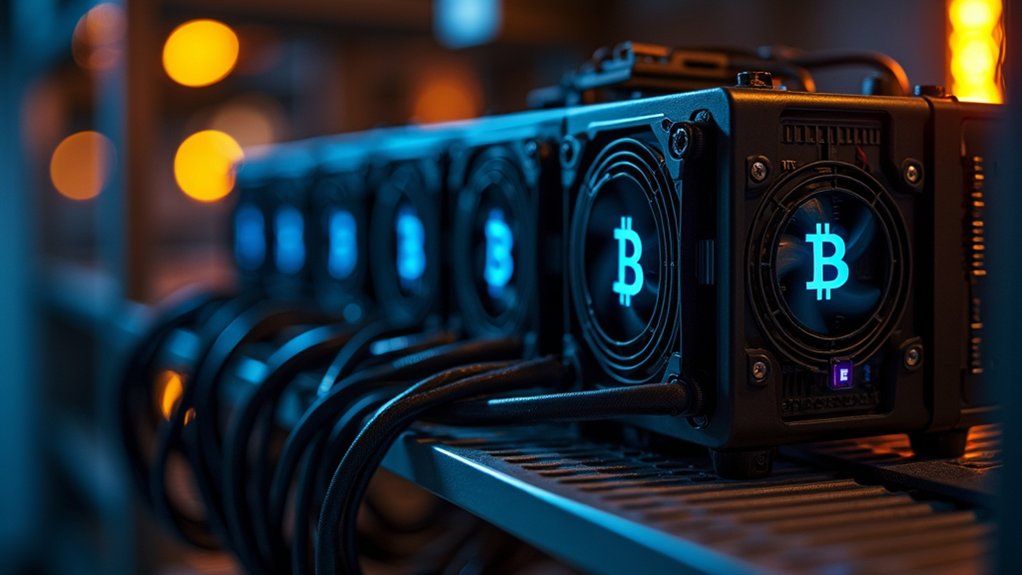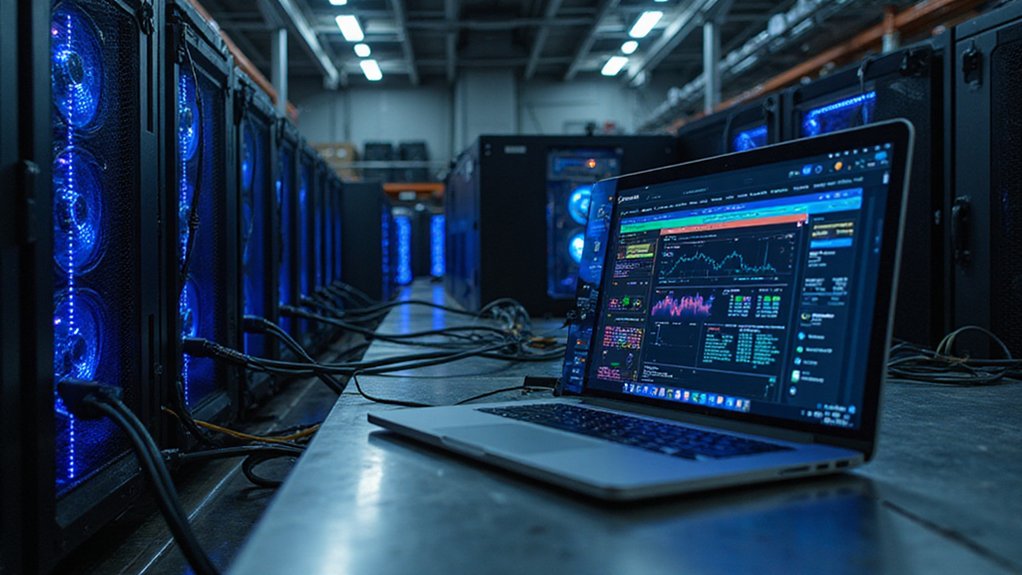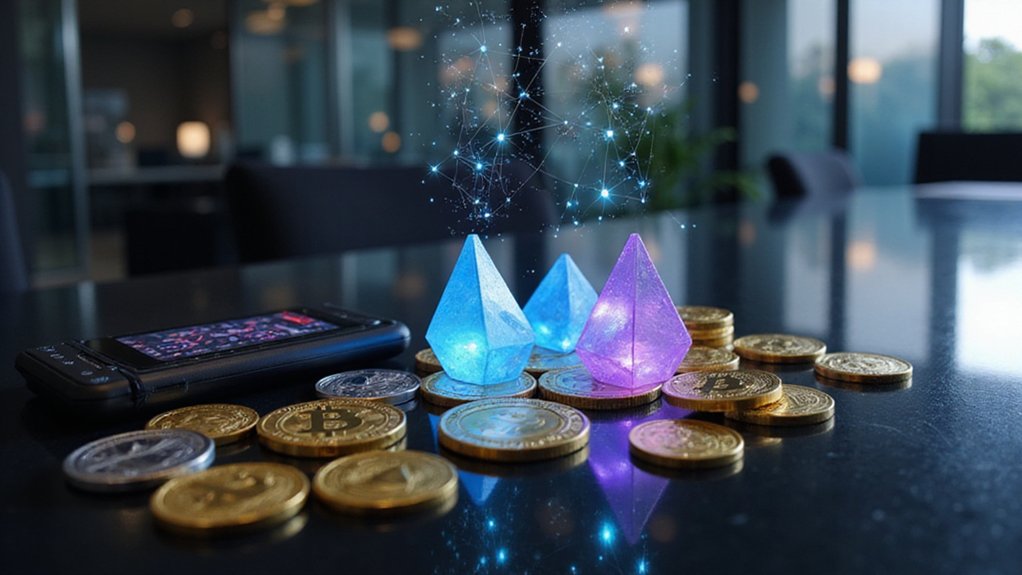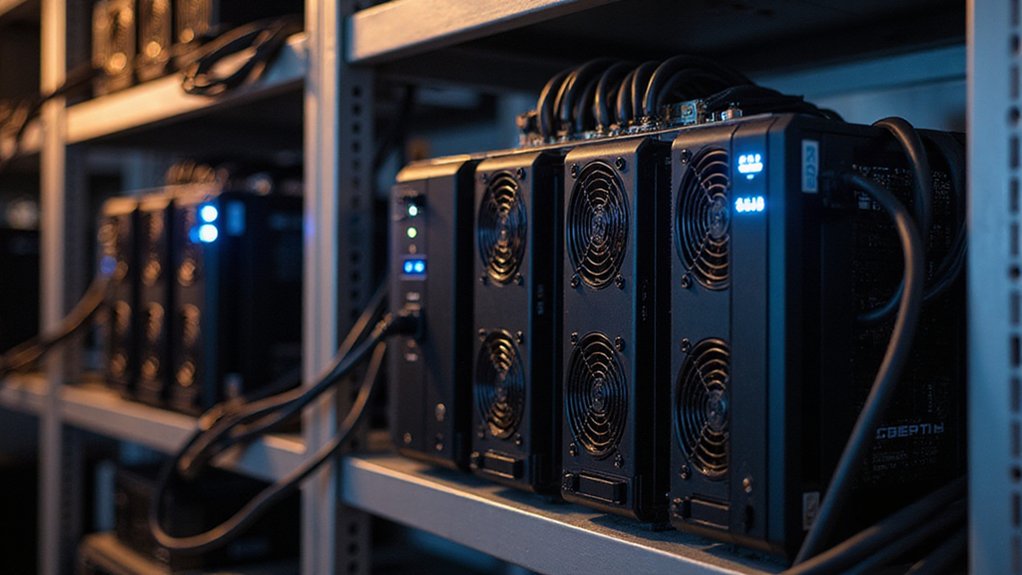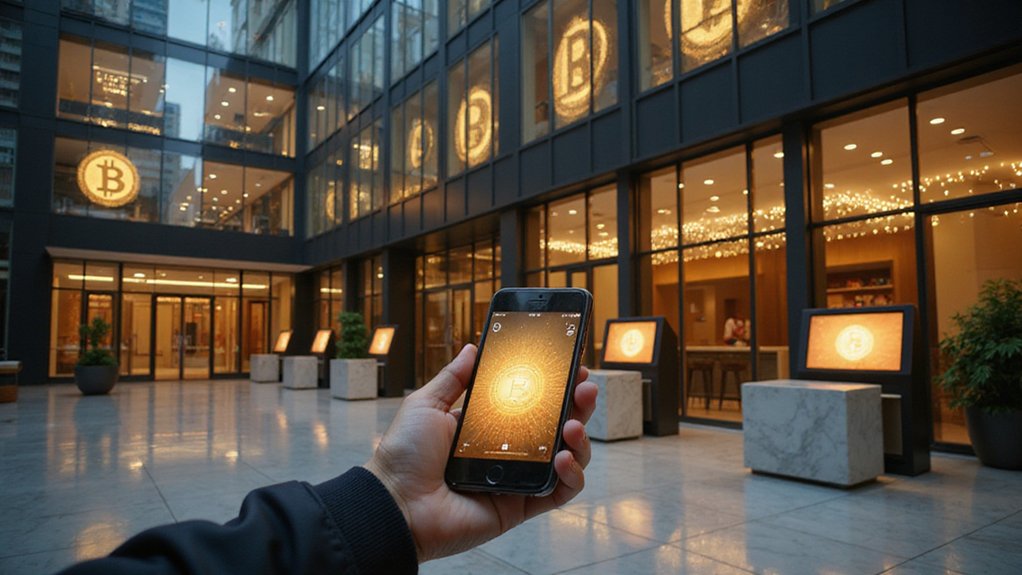Bitcoin mining requires specialized ASIC hardware to solve cryptographic puzzles that validate transactions and generate new coins, though the days of profitable basement operations have largely vanished. Miners compete to find nonces that produce hashes below target difficulty levels, earning 6.25 bitcoins per block plus transaction fees. Most join mining pools to improve odds, while electricity costs and cooling requirements often determine profitability—a reality that transforms digital gold rushes into industrial-scale endeavors worth exploring further.
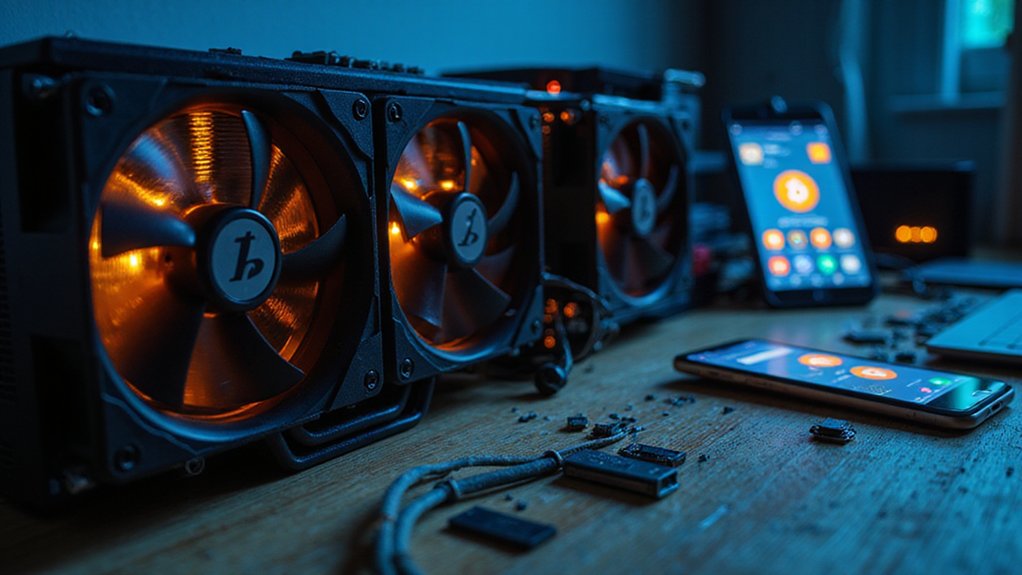
While most people acquire bitcoin through the considerably more straightforward method of purchasing it on an exchange, mining represents the fundamental process by which new bitcoins enter circulation—a digital equivalent of extracting precious metals from the earth, albeit one that requires solving cryptographic puzzles rather than wielding pickaxes.
The mining mechanism operates through Proof-of-Work consensus, where miners compete to solve complex hash puzzles linked to blocks of transactions. Each block contains inputs (bitcoin sources), outputs (destination addresses), and transaction amounts organized within a Merkle tree structure. Miners must discover a nonce that produces a hash below the target difficulty level—essentially playing a computational lottery where the house always wins, except when it doesn’t.
Hardware selection proves critical to mining viability. Graphics processing units (GPUs) offer versatility but pale beside application-specific integrated circuits (ASICs), specialized machines engineered exclusively for bitcoin mining with superior energy efficiency. Mining software connects these devices to the Bitcoin network, performing the requisite cryptographic calculations while a digital wallet stores earned rewards securely. Modern mining applications like MultiMiner provide graphical interfaces that simplify hardware management across different device types including GPUs, ASICs, and FPGAs.
The reward structure incentivizes participation through newly minted bitcoins plus transaction fees. Block rewards began at 50 bitcoins but halve approximately every four years—currently standing at 6.25 bitcoins per block as of 2025. This deflationary mechanism guarantees bitcoin’s 21-million coin supply cap while gradually shifting mining economics toward transaction fees rather than block rewards.
Mining pools allow individual miners to combine computational power, increasing reward probability through shared resources—a sensible approach given the astronomical odds of solo mining success. The network adjusts difficulty every two weeks to maintain consistent ten-minute block intervals, regardless of total mining power. Beyond individual profit motives, mining serves the broader purpose of network security by making any attempts to alter the blockchain computationally expensive and economically unfeasible.
Energy consumption remains mining’s Achilles heel, with electricity costs often determining profitability margins. Cooling systems become necessary to manage heat generation from mining rigs, while environmental concerns have sparked interest in renewable energy adoption. The mining process involves generating cryptographic hashes, which are 64-digit hexadecimal numbers with possibilities reaching one novemvigintillion.
Mining difficulty adjustments ensure that even as hardware efficiency improves, the network maintains its security through computational work—a beautifully engineered system where participants burn electricity to secure a ledger that exists purely as distributed mathematical consensus.
Frequently Asked Questions
Is Bitcoin Mining Legal in My Country?
Bitcoin mining’s legality varies dramatically by jurisdiction—ranging from explicit prohibition (China’s extensive ban) to enthusiastic embrace (El Salvador’s legal tender status).
Most developed nations, including the United States and European Union members, permit mining without federal restrictions, though local regulations regarding energy consumption may apply.
Prospective miners should consult current domestic legislation, as regulatory frameworks evolve rapidly, particularly concerning environmental impact and taxation of cryptocurrency activities.
How Much Electricity Does Bitcoin Mining Consume Monthly?
Bitcoin mining devours approximately 13-14 terawatt-hours monthly—roughly equivalent to Finland’s entire electrical consumption.
This staggering figure represents about 0.5% of global electricity usage, with individual transactions consuming up to 1,200 kWh each.
Daily consumption exceeds 5 gigawatts and continues climbing, potentially reaching 7.7 GW by year-end.
The network’s insatiable appetite mirrors Washington state’s monthly energy demands, raising eyebrows about sustainability.
Can I Mine Bitcoin on My Smartphone or Laptop?
Mining Bitcoin on smartphones or laptops represents an exercise in futility—theoretically possible yet practically worthless.
These devices lack the computational horsepower of specialized ASIC hardware, rendering profitability fundamentally zero while risking hardware damage through overheating.
Given Bitcoin’s astronomical difficulty levels and the substantial electricity consumption discussed previously, mobile and laptop mining attempts merely transform expensive electronics into inefficient space heaters that generate negligible returns.
What Happens When All 21 Million Bitcoins Are Mined?
When all 21 million bitcoins are mined around 2140, miners will lose block rewards entirely, surviving solely on transaction fees.
This creates an intriguing economic paradox: network security depends on miners remaining profitable through fees alone.
Bitcoin’s shift to a pure fee-based model may cement its role as digital gold—a settlement layer for large transactions rather than everyday purchases, with smaller trades relegated to secondary solutions.
How Long Does It Take to Mine One Bitcoin?
Mining one bitcoin requires approximately 4.5 years for individual miners equipped with high-end ASIC hardware—assuming they possess the fortitude (and electricity budget) to maintain continuous operations.
The network collectively mines bitcoin every 3.2 minutes, though solo miners face considerably less favorable odds.
Mining pools offer more frequent payouts by distributing rewards proportionally, transforming the otherwise Sisyphean task into manageable, if still expensive, monthly income streams.
